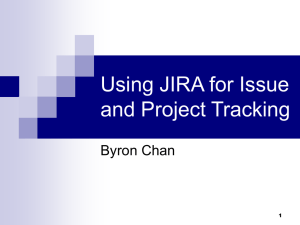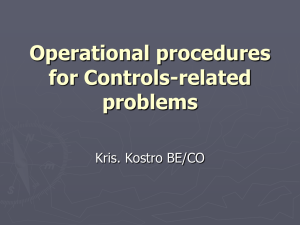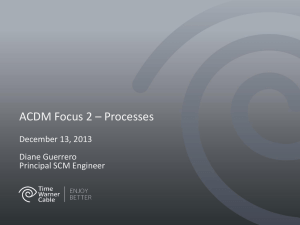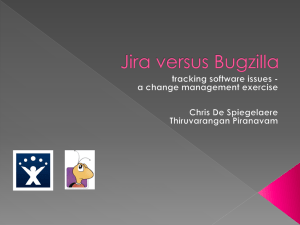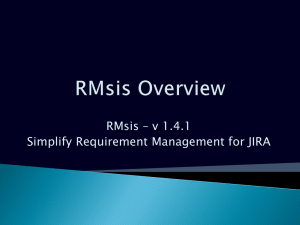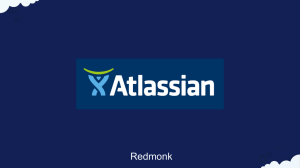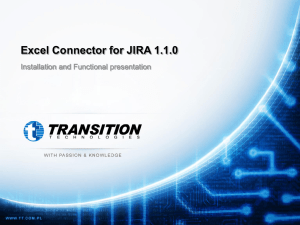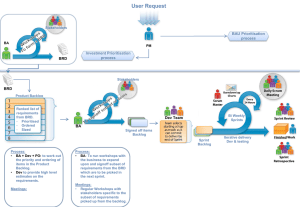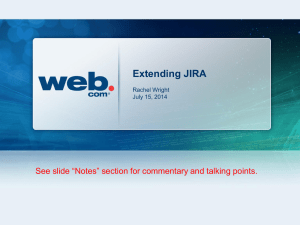JIRA - Acsys.it
advertisement
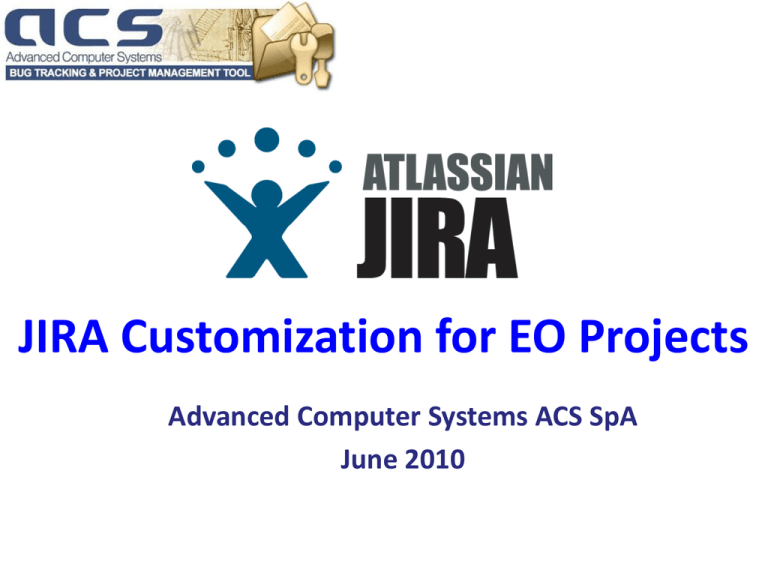
JIRA Customization for EO Projects Advanced Computer Systems ACS SpA June 2010 Scopes • The scope of this document is to provide useful information on how to use “JIRA” , a web based tool developed by Atlassian (see http://www.atlassian.com), for the Project Management of all ACS Projects. Who uses JIRA • JIRA is used for issue tracking and project management by over 11,500 organisations in 107 countries around the globe — across Fortune 1000, public enterprise, science and technology sectors. Some Customers… What is JIRA • JIRA is a bug tracking, issue tracking, and project management web application developed to make this process easier for both Customers and Contractor(s). • JIRA is based on the concept of generic “issues”, having each a given workflow with configurable states and actions. ACS work : Issue Types Typical Project Lifecycle End of Warranty Customer requests add ons or changes Changes Bug Tracking Kick Off Need of changes to SW in Vx version -> design team and restart the loop Design Phase Fix SW in Vx version -> maintenance team Integraton & Testing Validation & Delivery of SW in Vx version Project lifecycle Development Deliver SW in Vx version Release Typical Project Lifecycle End of Warranty Project lifecycle Kick Off Changes Design Phase Bug Tracking Integration & Testing Development Deliver SW in Vx version Release Issues can link each other Issues can be moved Issues in project reports JIRA PLUGIN AVAILABLE! MINUTES OF MEETING MONTHLY PROJECT REPORT USE STANDARD JIRA EXPORT (WORD,EXCEL) JIRA PLUGIN AVAILABLE! FICHIE DE DIALOG DELIVERY NOTE PLUGINS : MOM • A JIRA plugin “Mom Parser” is available to extract and load Action Items from a Minutes of Meeting. • The JIRA plugin , developed by ACS, permits to send an email to a JIRA’s mail box with an xls file (Microsoft Excel) as attachment, containing decisions and actions decided in the meeting . It allows then the creation of new Action Item issues extracted by the xls file; • The plug-in, after email processing, sends an email back, with an updated xls file attached, providing to each issue included in the original excel file the JIRA “unique” identifier EMAIL EMAIL MOM PARSER PLUGINS : MOM [pag 1-Cover Page] PLUGINS : MOM [pag 2- Agenda] PLUGINS : MOM [pag 3- Details Page] PLUGINS : MOM [pag 4- Summary Page] as filled by the plugin PLUGINS : Delivery Note • At each formal SW Delivery, the Contractor has to deliver to the Customer a formal Delivery note, containing a Company Protocol Identifier and detailed information on what has been delivered (i.e. SW installation kits, SW version,…) • The template form, to be sent via email as xls file, provides – a list of Installation Kits – a list of Installation Sites in which the SW Version has to be installed The plug-in extracts such information and creates corresponding issues in JIRA connected to such SW version. • The plug-in then “fills” the third page of the xls file with some Revision and Release Notes information, providing all the issues “closed” or at least set with “Fix Version” having the same identifier then the one set in the form itself. The plugin then reply to the original email with the updated xls file. EMAIL EMAIL Delivery Note Plug-in PLUGINS : Delivery Note [pag 1-Cover Page] PLUGINS : Delivery Note [pag 2- Installation Kits] PLUGINS : Delivery Note [pag 3-Release Note Page] as filled by the plug-in HOW TO CREATE A PROJECT • The JIRA administrator to contact ? Claudio Nasuti and as a back up solution contact Antonio Vollono. • The Users that have to be created ? ACS users already configured in the System. Only Customer and Subcontractors have to be created. Each project has a number or “Roles” that are normally mapped into Groups. • The information’s to provide to create it ? For each new User, an email address have to be specified. The password will be set as default to “12qwas” to be changed after first login. For each project, a “3 ascii digit” code for the proprietary issues has to be defined (e.g. “ACQ”). Also the appointed Project Manager has to be specified. • The Groups in which they have to be arranged and their Permissions ? The list of users to access the new Project has to include the specification to which “groups” they have to be assigned to within the Project scopes. Groups are: “Developers”, “Customer”, “Subcontractors” and “Project Managers”. Belonging to a specific group implies a specific permission scheme. HOW TO CREATE A PROJECT the form is available on http://jira.acsys.it Project Roles • • • • • Project Managers, a group having at least the Project Manager, the System Engineer and the AIV manager. In large Projects, also Facility Responsible(s) maybe part of this group. Developers team, formed by all the (ACS) staff working on the Project. Customer team, a group in which all Customer users have to be included. Sub-contractors team (occasionally), to group all users participating to the Project as subcontractors. Prime Contractor, for all those Projects in which ACS is not “prime”. Other Roles are set for Quality and Managerial issue and are shown in figure. They can be set also without creating a specific Group. To each Project Role JIRA provide permission to carry on actions (the PERMISSION SCHEME) HOW TO LOG ON JIRA • URL ? http://jira.acsys.it • How the tool is organized? It is organized in html pages: – a Dashboard page, – a Browse Project page, – a Create New Issue page. Dashboard is used to browse “issues” status and to have an high level view of them, such as : – how many, – which issue type, – to whom they are assigned to, – unassigned issues, – my unresolved issues, – issues assigned to me Browse Project is used to have a view at “project level” of the issues. Create New Issue, drives the user to create an issue with dedicated screens. HOW TO CREATE AN ISSUE (1) • Roles & Notifications Issues maybe created by Customers but also by the Contractor (i.e. ACS). Important roles are the “Reporter”, being the User creating an issue, and the “Assignee”, being the User having assigned the resolution of the issue. They’ll receive emails automatically upon each change of issue status. Also configured “Default Watchers” shall receive an email. For some issues, while creating, one can also add a list of user in the “Notify to” area. HOW TO CREATE AN ISSUE(2) • Responsibilities Responsibilities on any issue are regulated by the “workflow” assigned to each issue type. Nominally: • Reporter open the issue and will receive emails • Project Managers will have the duty to assign the issue to a user • Assignee has to resolve the issue at “unit level” • Project Managers and Customer (e.g. Reporter) have to verify that the issue is effectively closed at “system level”. • Project Managers (AIV) have the duty to then install the fix into the Reference and/or Operational System. HOW TO CREATE AN ISSUE(3) • Internal, Private and Public Issues It is in fact possible to create issue which are not “published” to all Users having rights to browse the project. This is useful to memorize and trace anything it is observed in the System, events requiring investigation which may not be “issues” for the “Project” at contractual level or which are not yet declared as “bugs” but only suspects. In order to do this JIRA Users, having permission to do it, have to use the “Security Level” field . HOW ISSUE IS EVOLVING (1) • Workflows each issue has to undertake Each issue has its own “statuses”. For each issue, statuses have to undertake to a “workflow” (see [JIRA_SUM]3.4.1 for generalities and following subsections for each issue workflow). JIRA controls the statuses for each issue and “guide” the user in the correct sequencing during the issue lifecycle. HOW ISSUE IS EVOLVING (2) • Who receives email warning on the issues JIRA emits an email on each status change or comment to : – – – The Reporter of the issue The Assignee to the issue All the Watchers of the issue Watchers are : - those users having seen an issue in which they are interested in and have requested JIRA (in the left pane of the “issue detail” page) to add their login to the watchers list. default watchers set in the Project Role while creating the Project users that while creating the issue have been set into the “Notify To” field (field available only for specific issues like SPRs). HOW ISSUE IS EVOLVING (3) • How to monitor periodically issues evolution and….a number of GOOD PRACTISES!!!! • Each User is suggested to log on JIRA daily and check the “issues” to which he has been assigned for. It is a good practise anyway to have a look to the recent issues opened in each Project for which the User is granted to access in JIRA to participate to the issue discussion. Each user is requested to subscribe to a special “filter”, the “Overdue in the next 5 days”. In this way he’ll be warned via email on the issues having a “Due Date” (i.e. AIL) going to expire (see “important note” in section 3.1.1.1). Force all the Project Team to discuss the issues in the tool and not (at least not only) via email. This shall allow a full log of all the discussions held over an issue. • • • WORKFLOWS : SPRs WORKFLOWS : HWI WORKFLOWS : RID HOW TO MANAGE SW VERSIONS (1) • Create a new Version JIRA provides the monitoring of “issues” in a project, all along its phases and can apportionate them to a period or a milestone. JIRA issues (e.g. SPRs) are “open” quite often on a SW Version, a commonly called “Release” and shall be “fixed” on another. HOW TO MANAGE SW VERSIONS (2) • Check Release details JIRA provides which issues have been fixed on which Release HOW TO MANAGE SW VERSIONS (3) • Administering a Release JIRA provides the capability to create but also to officially declare as “released” a SW Version SW Configuration Management : CVS • How CVS is linked to JIRA • Each time a Project is created, a member of the Project Managers has to link CVS modules used by the Project itself. [N.B. All CVS modules under “components” and “applications” in ACS CVS are already pre-loaded in JIRA (but need to be anyway assigned to become “monitored” by JIRA for such Project).] • In case new modules have to be created and then linked by a specific Project, a member of the Project team has to contact the JIRA system administrator SW Configuration Management : CVS • How CVS is linked to JIRA • Each time an issue is fixed by a SW modification, the Developer has to make a “CVS tag” and report the JIRA issue identifier as a comment (see next sections for details). • JIRA will then automatically log into the issue which CVS module has been corrected and therefore link the source code to the JIRA issues. JIRA External Integration General Software Development • • • • • • • • • • Email RSS Excel LDAP Active Directory CVS Subversion Perforce Visual SourceSafe FishEye
